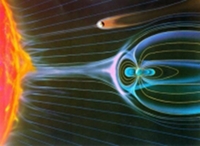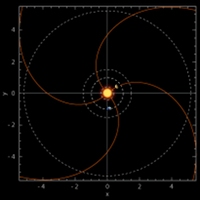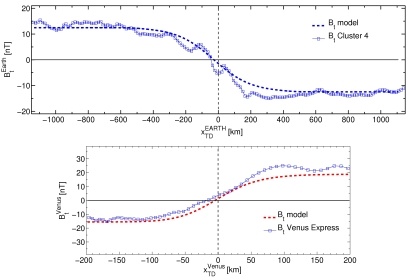ESA spacecraft model magnetic boundaries
7 January 2011
European scientists have used observations from ESA's Cluster and Venus Express spacecraft to improve models of the interaction of Earth and Venus with the solar wind, the perpetual stream of electrically charged particles emitted by the Sun. This has implications for understanding the effects of charged particles on orbiting spacecraft.
 |
|
The solar wind shapes the magnetospheres of Earth and Venus. Credit: ESA |
Whereas Earth's active internal dynamo is able to create an all-embracing magnetic field, Venus is unable to generate an internal magnetic field. As a consequence, Venus has a much smaller magnetosphere, which is induced by the interaction between the plasma in its sparse outer atmosphere and the solar wind.
Earth's magnetic environment and its interaction with the variable solar wind have been explored by orbiting spacecraft for decades, resulting in a good understanding of the location and width of the outer boundary of the magnetosphere, the so-called magnetopause. However, only a few spacecraft have orbited the second planet from the Sun, and there are still many gaps in our understanding of the Sun-Venus connection.
In order to fill some of the gaps in our knowledge, a team of European scientists have developed a model of the magnetopause, which takes into account the different plasma conditions at both planets. The study, published in the journal Planetary and Space Science, uses data obtained by ESA's Venus Express orbiter and the four spacecraft of ESA's Cluster flotilla in Earth orbit.
 |
|
Positions of Venus and Earth in the ecliptic plane, on 27 June 2006. Credit: ESA |
A few hours later, the Cluster quartet crossed the terrestrial magnetopause, on the dawn flank of the magnetosphere. Particle data from the Cluster ion spectrometer and magnetic field data from the magnetometer gave a multi-point description of the conditions at the edge of Earth's magnetic bubble.
The near-simultaneous joint observations by Venus Express and Cluster enabled the team to complete a comparative study of the solar wind interaction with the outer magnetospheric layers of Venus and Earth. The scientists were also able to compare the spacecraft data with the results of kinetic models of plasma interfaces which they had adapted for the magnetopauses of the two planets. It was the first time that this type of kinetic model had been tested on two very different plasma environments.
"We chose that day because we knew that the spacecraft were crossing the planets' magnetopauses at the same time and the conditions were comparable," explained Marius Echim of the Institute for Space Sciences, Romania, and the Belgian Institute for Space Aeronomy in Brussels, who was lead author of the paper.
 |
|
Model and magnetic field data collected during a magnetopause crossing of Earth and Venus. Image courtesy of Marius Echim, IASB, Brussels, Belgium. |
Although Earth and Venus were not in the same solar wind stream, the particles from the Sun were flowing steadily outward at about 300 km/s. Furthermore, there were no major fluctuations in the magnetic field, ion temperature and density.
"We were able to compare the two magnetopauses, including their thickness, current density and several electrodynamic properties," said Echim.
"Our results suggest that the kinetic structure of the magnetopause at Venus is dominated by ions of solar wind origin, with some contribution from the planetary plasma. The structure of the terrestrial magnetopause is different, with the terrestrial plasma and magnetic field playing the major role in determining its shape and electrodynamic properties.
"The thickness of the magnetopause is also different: roughly 1500 km across for Earth, compared with about 200 km for Venus.
"Our model had never previously been applied to Venus, so we were pleased to see that it predicted the conditions very well. It was also able to provide a much higher time resolution than the plasma instrument on Venus Express, showing in much greater detail how the ions and electrons interact with the magnetopause."
According to Echim, the model also could be applied to other planets, particularly Mars, which has localised pockets of remnant magnetic field, and Saturn, which is being explored by the Cassini orbiter.
"The comparative study of planetary plasma environments contributes to a better understanding of the general principles that govern magnetospheric configuration and dynamics, in particular the role of the solar wind state and of the planetary plasma environment," he said.
Such studies also help to predict the conditions experienced by orbiting spacecraft. The ability to model and predict the location of the planetary magnetopause is important, since major changes in solar wind pressure can cause the magnetic field to balloon in and out. In extreme cases, geostationary satellites may fly outside the protection of the magnetic bubble, putting them under direct assault by solar flares and coronal mass ejections.
Other authors of the paper were: R. Maggiolo and J. De Keyser of the Belgian Institute for Space Aeronomy, Brussels; T. L. Zhang of the Space Research Institute in Graz, Austria; G. Voitcu from the Institute for Space Sciences in Romania; and S. Barabash and R. Lundin of the Swedish Institute for Space Physics in Kiruna.
Reference Publication
Echim, M., et al., Comparative investigation of the terrestrial and Venusian magnetopause: Kinetic modelling and experimental observations by Cluster and Venus Express, Planetary and Space Science, May 2010. DOI: 10.1016/j.pss.2010.04.019
Contacts
Marius Echim
Space physics department
Institut d'Aeronomie Spatiale de Belgique (IASB)
Brussels, Belgium
and Institute for Space Sciences (ISS), Bucharest, Romania
Phone: +32 2 3730418
Email: marius.echim oma.be
oma.be
Matt Taylor
Cluster Project Scientist
Directorate of Science and Robotic Exploration
ESA, The Netherlands
Phone: +31 71 565 8009
Email: Matthew.Taylor esa.int
esa.int
Håkan Svedhem
Venus Express Project Scientist
Directorate of Science & Robotic Exploration
ESA, The Netherlands
Phone: +31 71 565 3380
Email: hsvedhem rssd.esa.int
rssd.esa.int

